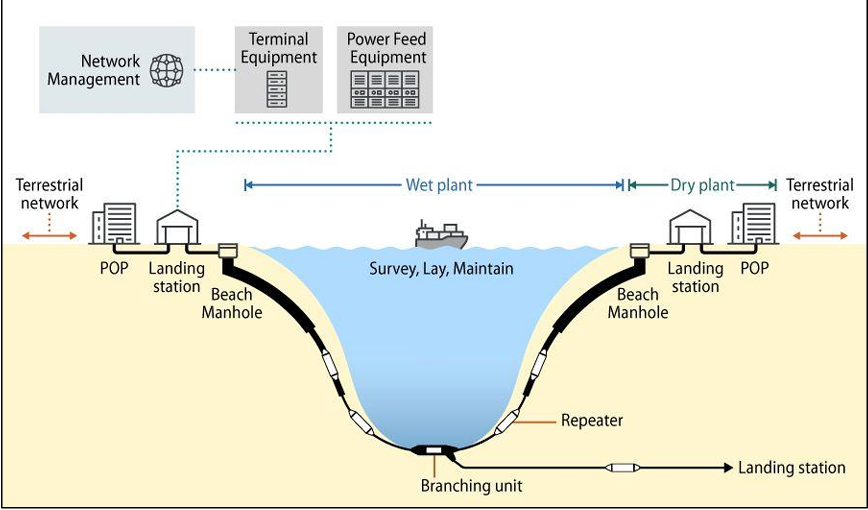Syllabus: GS3/Infrastructure
Context
- India is currently experiencing a significant boost in its digital backbone with the landing of new undersea cable systems, marking a pivotal step in enhancing its international bandwidth capacity and global internet connectivity.
- Two major systems—2Africa Pearls, backed by Meta, and SEA-ME-WE-6 (Southeast Asia-Middle East-West Europe-6)—have made their landing in India in 2024, specifically at Chennai and Mumbai.
The SEA-ME-WE 6
- It is a 21,700km submarine cable system between Singapore and France (Marseille), crossing Egypt through terrestrial cables.
- The SMW6 (SEA-ME-WE 6) consortium includes telecommunications companies from countries like Bangladesh, Singapore, Malaysia, Indonesia, Thailand, Sri Lanka, India, Pakistan, Saudi Arabia, Qatar, Oman, the UAE, Djibouti, Egypt, Turkey, Italy, France, Myanmar, and Yemen
What Are Undersea Cables?
- Undersea cables connect global internet networks, providing vast data transfer capacity via fiber optic strands.
- These cables land at designated points and are linked to terrestrial networks.
- They connect internet service providers and telecom operators everywhere with those in other countries.
- These cables are a few inches thick and are heavily padded to withstand the hostile environment of the sea floor.
- Importance of Undersea Cables: About 90% of global data, 80% of world trade, and key financial and government transactions rely on undersea cables.

Fig1: Undersea Telecommunication Cable System
India’s Cable Infrastructure
- India has two main cable hubs, Mumbai and Chennai, with 17 cable systems landing there.
- India also has two domestic cable systems — the Chennai Andaman and Nicobar Islands (CANI) cable to provide high-speed connectivity to the islands, and the Kochi Lakshadweep Islands project.
| Project Waterworth by Meta: – Meta introduced its subsea cable project, Project Waterworth, which will span 50,000 km, becoming the longest subsea cable project in the world. – The project aims to enhance global connectivity, focusing on locations such as the U.S., India, Brazil, South Africa, and others. – The investment for the project involves billions of dollars and is set to span multiple years, with a focus on providing AI access to users worldwide. Impact on India: – Project Waterworth will help accelerate India’s digital infrastructure growth and support the country’s plans for its digital economy. Technical Details: – The cables will be laid at depths of up to 7,000 meters. – Special measures will be implemented to protect cables in high-risk areas where damage is more likely. |
Concerns
- Capacity and Future Demand: While current capacity is adequate, the increasing data traffic may outgrow existing infrastructure, prompting concerns over future sufficiency.
- Risks of Cable Disruptions: 570 global subsea cables handle 90% of world data and 80% of trade.
- If there’s a disruption at the Red Sea, 25% of India’s internet is affected.
- India lacks local vessels for cable repairs, leading to delays.
- Challenges in Cable Deployment: Excessive regulatory permissions slow down the process.
| International Cable Protection Committee (ICPC): – Founded in 1958, it is a global forum for governments and commercial entities in the submarine cable industry. – Its mission is to improve the security of undersea cables by providing a platform for sharing technical, legal, and environmental information. |
Improvement Suggestions:
- Streamlining the regulatory process and investing in local cable repair infrastructure are essential to improving India’s subsea cable capabilities.
- The government should categorize subsea cables as critical telecom infrastructure to secure tax exemptions and encourage investment.
- There’s a call for better regulatory clarity and the establishment of a separate cable corridor to prevent damage from fishing activities.
| What are Optical Fibers? – They are incredibly thin strands of very pure glass or plastic. They transmit information in the form of light pulses. How do they work? – They work on the principle of Total Internal Reflection (TIR). An optical fiber has a central core surrounded by a cladding layer. The core has a slightly higher refractive index than the cladding. – When light enters the core at a certain angle, it keeps bouncing off the cladding due to TIR, traveling down the fiber with minimal loss. |
Source: TH
Previous article
Forest Rights Act (FRA)
Next article
News In Short-4-04-2025